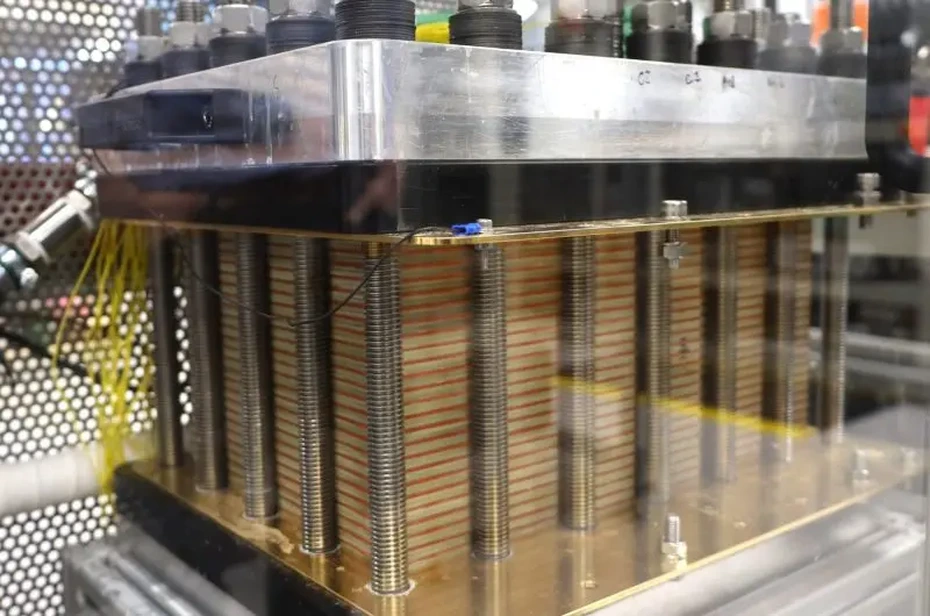이슈 진단 ① 위기 속 건물용 연료전지산업 살리자
신재생에너지 보급사업 예산 급감…건설경기 악화까지
발전용 연료전지 중심 정책으로 건물용 연료전지 ‘나 몰라라’
제로에너지건축물과 비상전원에서도 연료전지 소외
연료전지 제조사, 해외수출 등으로 위기 돌파
정부의 주택·건물용 연료전지 설치 지원예산과 보조금이 2023년부터 급격히 줄고 있다. 여기에 건설경기 악화까지 겹치면서 연료전지 보급이 하락세다. 국내 연료전지 정책은 발전용 중심으로 추진되고 있어 사실상 건물용 연료전지 정책은 실종된 상태다. 낮은 가동률·경제성, 높은 설치비용 등의 고질적인 문제로 건물용 연료전지에 대한 부정적 인식이 팽배해지면서 신재생에너지 의무화 사업에서조차 설 자리를 잃어가고 있다.
신규시장인 제로에너지건축물과 비상전원에서도 소외당하고 있다. 정부 정책 방향의 재설정이 필요한 시점이다.
월간수소경제는 연속기획(총 3회)으로 연료전지의 장점과 역할이 있음에도 불구하고 건물용 연료전지산업이 위기에 빠진 요인을 분석해보고 새로운 발전 방향을 모색한다. 첫 번째로 건물용 연료전지산업의 현실과 기회 요인을 짚어본다
건물용 연료전지 보급 하락세
연료전지 업계에 따르면 국내 건물용 연료전지는 정부의 신재생에너지 설치 지원사업(주택·건물)을 통해 2014년부터 본격적으로 보급되기 시작되어 2024년 6월 말 기준 누적 설비용량은 2만5,433kW(1,405개소)를 기록했다.
건물용 연료전지 제조사로는 에스퓨얼셀과 두산퓨얼셀파워BU(두산모빌리티이노베이션에 합병)가 시장을 지배해왔다.
연료전지는 기존 발전 방식보다 높은 약 43~60%의 발전효율을 보이고, 100% 배열 회수 시 종합효율은 약 90%에 달한다. 기후조건과 무관하게 안정적인 설비운영이 가능해 높은 이용률을 자랑한다. 2021~2023년 연료전지의 이용률은 약 83~92% 수준이었다.
또 kW~MW급 소·대규모로 수요지 인근에 설치할 수 있고 송전망 설치에 따른 사회적 비용을 줄일 수 있다. 수요를 초과하는 재생에너지 전력의 장주기 저장수단뿐만 아니라 출력 증감발이 수초~수분 내이고 셧다운 후 정상 출력을 위해 타입별로 0.5~2일 정도 소요되어 유연성 전원으로 활용이 가능하다.
도시가스 개질 수소를 이용 중인 연료전지 시스템 내 개질기 제거 후 청정수소 연료전지로 즉시 전환할 수 있다. 이러한 특장점으로 인해 발전용, 주택·건물용으로 설치되고 있다. 국내는 주택·건물용 중 건물에 연료전지 설치가 집중되어 있다.
일본의 경우 주택용(가정용) 연료전지 설치가 활성화되어 있는데, 일본 정부도 이러한 연료전지 특장점과 함께 온실가스 감축 효과까지 인정하면서 에너팜 보급사업을 통한 보조금 지원을 통해 2023년까지 약 50만3,000대(누적)의 연료전지를 보급했다.
정부가 2019년 1월 발표한 ‘수소경제 활성화 로드맵’을 통해 가정·건물용 연료전지 보급(누적)을 2022년 50MW, 2040년 2.1GW로 확대한다는 계획을 발표하면서 건물용 연료전지산업의 지속 성장에 대한 기대감이 컸다.



우선 신재생에너지 보급사업 예산의 단계적 확대로 건물용 연료전지 보급 확산을 지원한다고 밝혔지만 실제로는 지원예산이 줄어드는 추세다.
정부는 공공기관(연면적 1,000㎡ 이상 건축물) 의무설치(신재생에너지법), 지자체 조례(녹색건축조례)에 따른 일정 면적 이상의 주거·영업용 건물 의무설치, 의무설치 대상 외 희망자를 대상으로 건물용 연료전지 설치보조금을 지원하고 있다.
한국에너지공단의 주택·건물지원사업(2021~2025년) 예산 및 보조금 자료를 보면 주택용과 건물용 연료전지 예산과 보급량, 보조금액(kW당)이 2022년 이후 매년 줄었다.
건설경기 악화도 연료전지 판매 감소로 이어졌다. 한국건설산업연구원은 지난해 11월 6일 개최한 ‘2025년 건설·부동산 경기전망 세미나’에서 2022년 248조4,000억 원으로 역대 최대치를 경신한 건설수주는 2023년엔 전년 대비 16.8% 감소한 206조7,000억 원으로 하락했고, 2024년에도 0.4% 감소한 205조8,000억 원을 기록할 것으로 전망했다. 2025년에는 전년 대비 2.2% 증가한 210조4,000억 원으로 회복할 것으로 내다봤다.
건설투자의 경우 2022~2023년 건축 착공이 감소한 영향이 2024년 하반기부터 2025년까지 건설투자 부진으로 나타나 2024년에는 전년 대비 1.4%, 2025년에는 전년 대비 2.1% 하락할 전망이다.
이지혜 한국건설산업연구원 연구위원은 “올해 1월에 이어 2월에도 건설기업 경기실사지수(CBSI)가 하락세를 보이며 체감 건설경기 부진이 계속 이어지고 있다”라며 “종합전망지수도 100 이하로 건설경기에 대한 부정적 전망 비중이 높은 상황이 지속되고 있다”고 설명했다.
상황이 이렇다 보니 연료전지 제조사의 영업실적이 좋지 않다. 국내 건물용 연료전지 1위 기업 에스퓨얼셀은 매출액이 2020년 470억 원, 2021년 473억 원, 2022년 468억 원으로 정체 현상을 보이다가 2023년은 325억 원으로 2022년 대비 30.5%나 줄었다. 영업이익과 당기순이익도 2022년부터 줄어들기 시작해 2023년에는 2022년 대비 각각 -25억 원, -23억 원을 기록해 적자로 전환했다. 2024년 매출액은 2023년 대비 3.5% 증가한 336억 원을 기록했지만 영업이익은 –41억 원, 당기순이익은 –12억 원으로 적자를 면치 못했다.
건물용 연료전지 정책 실종
건물용 연료전지에 대한 정부의 인식도 문제다. 수소경제 정책을 보면 연료전지는 발전용 중심이다. 규모의 경제를 통한 단가 절감효과가 크고 수출산업화가 가능해 정책 지원 성과가 두드러지기 때문으로 보인다.
실제로 정부는 수소정책 성과를 홍보할 때 발전용 연료전지를 맨 앞에 내세운다. 한국은 올해 1월 말 기준 약 1,105MW를 보급한 세계 최대의 연료전지 발전시장이다. 사실상 전 세계적으로 발전용을 중심으로 연료전지를 보급하는 국가는 한국이 유일하다. 미국, 일본, 중국, EU, 호주 등의 국가들은 분산형 전원(데이터센터, 상업시설 등), 가정·건물용, 열병합 발전원, 재생에너지 간헐성 보완용 등으로 연료전지 보급 확대를 추진하고 있다.
정부는 2040년까지 8GW(누적)의 발전용 연료전지를 보급한다는 계획이다. 2040년에는 2018년(설치비 450만/kW, 발전단가 250원/kWh) 대비 설치비 35%, 발전단가 50% 수준을 달성할 것으로 예상하고 있다. ‘제5차 수소경제위원회’에서 확정한 ‘세계 1등 수소산업 육성 전략’을 통해 수출산업화 대상으로 선정한 5대 분야 중 하나는 발전용 연료전지이다.
정부가 건물용 연료전지 보급 확산 방안으로 제시한 LNG 전용 요금제 신설 외에는 병원·데이터센터 등에서 활용 중인 비상전원(디젤·가솔린 등 사용 발전기)을 ‘연료전지+ESS 시스템’으로 대체, ‘연료전지 대여사업’ 등 새로운 비즈니스 모델 발굴, 전기요금 특례제도 연장 검토 등 추가적인 인센티브 마련 계획은 공염불에 그치고 있다.
서울시 정책도 건물용 연료전지 업계에 큰 실망을 안겼다. 서울시가 2022년 3월 행정예고를 통해 2021년 10월부터 시행한 ‘민간 신축건축물 연료전지 설치 의무화’를 1년도 안 돼 폐기함에 따라 안정적인 민간 의무화시장이 송두리째 사라져버렸다.
제로에너지 건축 의무화 시행에 따른 ‘에너지자립률’ 적용으로 개별에너지 생산시설의 의무 공급비율이 필요하지 않고, 사업자 선택의 자율성을 확대한다는 취지라는 게 서울시의 설명이었다.
당시 서울시 연료전지 보급 담당 부서(녹색에너지과) 관계자는 “연료전지 설치 의무비율이 최종 폐기되면 다른 방안으로 연료전지 보급 확대를 위한 정책적 노력을 펼칠 것”이라며 “연료전지도 건물 비상전원에 포함하는 방안을 적극 추진 중”이라고 밝혔지만 소방청의 부정적 의견으로 인해 아직도 실현되지 못하고 있다.
이처럼 건물용 연료전지 정책이 실종됨으로써 2024년 6월 말 기준 누적 설비용량이 약 25.4MW로, 정부가 목표한 2022년 50MW 목표를 달성하지 못했고 2040년 2.1GW 달성도 요원하다는 비관론이 지배적이다.
건물용 연료전지 위기 속 기회
올해부터 민간에도 본격적으로 시행되는 제로에너지건축물(ZEB) 인증제도는 건물용 연료전지 업계가 가장 큰 기대를 거는 신시장이지만 연료전지가 들어서기 힘들도록 설계되어 있다는 지적이 계속 제기된다.
이 제도는 건축물에 필요한 에너지 부하를 최소화하고, 신재생에너지를 활용해 에너지 소요량을 최소화하는 녹색건축물을 대상으로 에너지자립률에 따라 1~5등급으로 인증을 부여하는 것으로, 건축물 에너지효율등급 1++ 이상, 에너지자립률 20% 이상, 건물에너지관리시스템(BEMS) 또는 전자식 원격검침 계량기 설치를 인증기준으로 한다.
연료전지 업계와 전문가는 ECO2 프로그램 평가 방법의 개선이 필요하다고 입을 모은다.
임한솔 한국건설기술연구원 수석은 “현재 제로에너지건축물 인증제도는 ECO2 프로그램 평가를 통해 이뤄지고 있는데, 해당 프로그램 내에서 연료전지는 열병합발전의 항목으로 평가되고 있어 연료전지가 건물 내에서 제한적으로 사용될 수밖에 없고, 최근 열을 사용하지 않는 방식의 발전 전용 연료전지 제품에 대한 수요가 발생하기에 평가 방식에 대한 보완이 시급하다”고 지적했다.
임 수석은 “연료전지가 건물에서 사용될 때 열 활용과 관련해 계통의 복잡성 증가, 축열 공간 확보, 열 손실에 따른 효율 저하 등 다양한 기술적 문제가 신뢰할 수 있는 수준으로 제어되어야 하고, 열 기반 냉방 기술의 개발과 상용화도 활성화되어야 할 것”이라며 “또 연료전지의 제품별 특성에 따라 잉여에너지가 발생할 것으로 예상되기에 VPP(가상발전소)와 같이 잉여에너지 거래로 해결하는 제도적 측면과 함께 기술적으로 잉여에너지를 다양한 형태의 에너지로 저장했다가 자체적으로 건물에서 소비할 수 있는 시스템의 개발과 상용화가 이뤄져야 연료전지를 신재생 분산에너지로 활용할 수 있는 환경이 구축될 것”이라고 제언했다.
기존 건축물의 탄소중립과 분산전원에 대한 정부의 인식 부족 문제도 제기된다.
정부가 기존 건축물에 대한 연료전지 설치보조금 제도를 신설해 도시가스 공급이 가능한 아파트 등 기존 건축물에 연료전지 설치를 확대해야 한다는 의견이 나오고 있다.
김주일 에스퓨얼셀 사업기획부장은 “국내는 주거 부문에서 아파트가 차지하는 비중이 50% 이상으로, 누진 3단계와 열 수요가 있는 기축 아파트는 연료전지를 설치할 수 있는 최적의 환경을 갖추고 있고 확장성이 크다”라며 “이런 기축 아파트에 대한 연료전지 설치는 운영 경제성 확보로 가동률 향상과 설치비용 하락이라는 선순환 효과를 가져올 것”이라고 설명했다.
정부는 연료전지 사용자의 불만을 해소하기 위한 R&D의 필요성을 강조한다.
정성욱 한국에너지기술평가원 연료전지 PD는 “운영 경제성 부족과 잦은 고장은 건물용 연료전지의 고질적인 문제이고, 지금은 도시가스 기반 연료전지여서 탄소중립이 어려울 것이라는 지적도 해결해야 하는 숙제”라며 “전기효율 향상(55% 이상), 시스템 가격 인하(kW당 250만 원 이하), 내구성 향상(20년 운전 기준 7년 이상 스택 사용 가능)이 정부가 추진하는 연구개발 목표”라고 설명했다.
연료전지 제조사들은 가동률 향상 노력을 지속 추진 중이다.
김석규 전 두산퓨얼셀파워BU 전략팀장(현 두산모빌리티이노베이션 드론사업 전략팀장)은 “과거에는 건물용 연료전지의 품질과 A/S에 대한 고객의 불만이 많았던 게 사실”이라며 “당사는 연료전지의 가동률 향상을 위해 핵심부품인 스택의 4만 시간 수준의 내구성을 확보하고 실시간 사전 모니터링 시스템을 도입해 이상징후 발생 시 사전 인지해 출장 A/S를 하고 있다. 가동 경제성 극대화를 위한 높은 전기효율의 시스템(중저온 SOFC 시스템) 개발에 투자하는 노력도 해왔다”고 밝혔다.
김 팀장은 “제조사는 연료전지가 건물에너지관리시스템(BEMS)과 연계되기에 기기 효율 증대와 열 활용 시스템 개발 노력을 지속하는 한편 국내 실적을 기반으로 해외 진출을 추진하고 PEMFC 기술 기반 사업 포트폴리오를 모빌리티로 확대해야 할 것”이라며 “분산에너지법 기반 건물 간 전력거래 제도 수립, 건물용 연료전지 가동 인센티브(신재생에너지 전기요금 할인 특례 부활 등) 도입, 연료전지 전용 가스요금 제도 유지 등의 정책 지원이 필요하다”고 밝혔다.
해외 진출의 경우 에스퓨얼셀이 적극적으로 나서고 있다. 유럽, 일본, 대만, 인도, 미국을 주요 타깃 국가로 선정한 에스퓨얼셀은 이미 2022년 9월에 국내 최초로 5kW급 건물용 연료전지의 유럽 CE 인증을 획득했고, 순수 수소용 제품 CE 인증도 확보할 계획이다. 지난 3월에는 대만에 처음으로 연료전지를 수출했다.
또 에스퓨얼셀은 도시가스 기반 연료전지의 탄소배출을 감축하기 위한 기술개발 노력도 하고 있다. CO2 포집 연계형 저탄소 건물용 개질기 기술을 개발해 건물용 연료전지에서 나오는 탄소를 포집해 스마트팜의 식물 재배에 활용하는 실증 평가를 진행 중이다.
비상전원도 연료전지 업계의 신시장으로, 서울 등 대도시의 전력자립률을 높이고 분산전원 활성화에 기여할 수 있는 방안으로 평가된다.
일정 규모 이상 건축물에는 피난용 승강기와 소방설비에 일정 시간 이상 전력 공급이 가능한 비상전원 설치를 의무화하고 있다. 현재 디젤, 가솔린, 가스터빈 등의 내연기관과 축전지, 에너지저장장치(ESS) 등이 비상발전기로 규정되어 있으나 연료전지는 이에 포함되어 있지 않다.
연료전지 업계는 현재의 연료전지 기술 수준으로 디젤발전기나 ESS를 대체할 수 있기에 연료전지도 비상전원에 포함하는 법적 근거를 마련하고, 신재생에너지법에 근거해 기존 건물용 연료전지와 같은 설치비를 지원해야 한다는 의견이다.
일본은 2006년에 소방청 고시를 통해 소방법에서 연료전지를 비상전원으로 인정하고, 재난 대비와 분산발전 목적으로 연료전지 가동을 적극적으로 권장하고 있다.
이슈 진단 ① 위기 속 건물용 연료전지산업 살리자 < 기획•연재 < FOCUS < 기사본문 - 월간수소경제
이슈 진단 ① 위기 속 건물용 연료전지산업 살리자
정부의 주택·건물용 연료전지 설치 지원예산과 보조금이 2023년부터 급격히 줄고 있다. 여기에 건설경기 악화까지 겹치면서 연료전지 보급이 하락세다. 국내 연료전지 정책은 발전용 중심으로
www.h2news.kr



